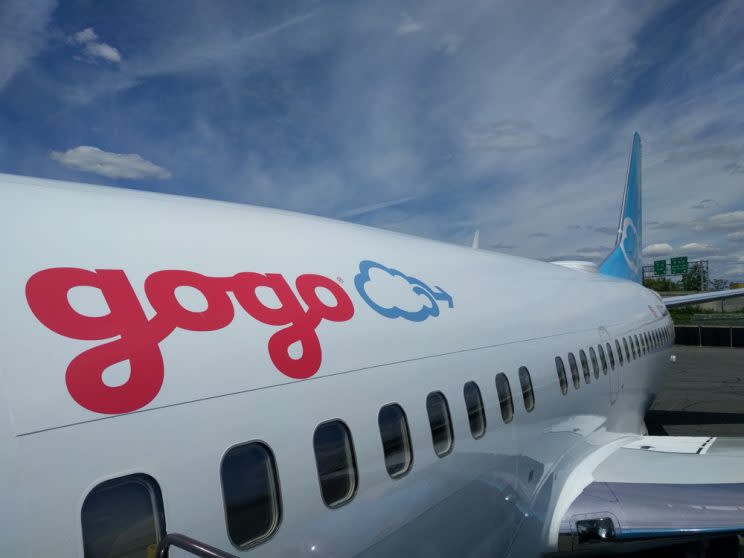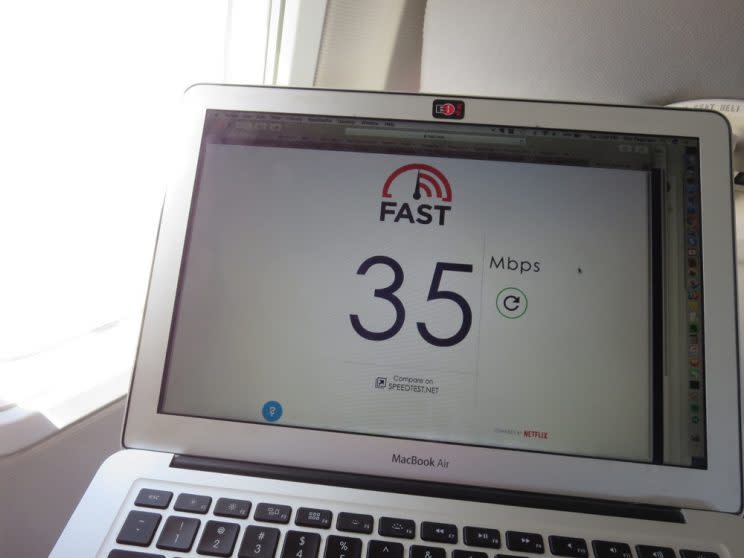How Gogo will transform your Wi-Fi experience in the sky

Inflight Wi-Fi based on air-to-ground cellular connections has a terrible reputation for being too slow and expensive.
And that’s only gotten worse as the leading purveyor of it, Gogo (GOGO), has tried to keep a minimum level of connectivity by jacking up prices on transcontinental flights to as much as $40. That’s made the Chicago-based company extraordinarily unpopular among many frequent travelers — and even some airline CEOs.
“It’s not good,” Delta (DAL) CEO Ed Bastian told Cranky Flier blogger Brett Snyder in an interview. “I told the Gogo guys that in my mind, they’re ‘no go’.”
But now Gogo is trying to make in-flight Wi-Fi fast enough for you to stream movies while more than a mile in the air.
Test flight
Gogo has spent the last few years deploying faster, satellite-linked service. And Tuesday it invited a small group of journalists to Newark International Airport to try its latest setup on the 737 it employs as a flying lab.
That revised configuration improves on the “2KU” system I tested on a flight out of Austin last March in two ways: an upgraded modem that can distribute 100 megabits of bandwidth to the cabin and a high-throughput Intelsat (I) satellite.
Everyday chores like checking social media, email and listening to streaming music on Spotify were no problem. Streaming an episode of “Portlandia” on Netflix, however, fell a little short of high definition even before I started downloading a 227MB copy of the free LibreOffice productivity suite.
Download speed tested via Netflix’s (NFLX) fast.com site averaged 32.8 Mbps, with the worst performance a still-impressive 26 Mbps.
But upload speeds — which fast.com doesn’t report but which I checked at speedsmart.net, a site suggested by Gogo chief technical officer Anand Chari — ran much slower. That site clocked my uploads at an average of 6.1 Mbps, with downloads averaging 34.1 Mbps.

Satellite connections inevitably suffer almost a second of lag time, thanks to your data taking a 44,000 mile detour to geosynchronous orbit. I didn’t notice that latency in practice, but it would be obvious in some online games.
While I didn’t encounter any apps blocked by Gogo, some test sites failed to load. Speedtest.net never managed to start, while Measurement Lab’s tests often failed halfway through. When it worked, it reported latency of as little as 2 milliseconds — an impossible figure, since data can’t zip from the satellite to the plane faster than the speed of light.
“All of these web sites suffer from some measurement error,” observed Chari.
The airlines can still mess this up
Still, it’s going to be a while before anybody but Gogo’s invited guests can enjoy this experience. The company won’t start installing this souped-up modem and upgrading the 170 existing 2KU planes until the second half of this year.
When that happens, Gogo marketing vice president Steven Nolan warned that airlines will throttle back uploads further.
“The upload speeds will be even narrower than that, because airlines don’t want a full plane of people doing FaceTime and Periscope,” he said.
But the bigger problem is all the aircraft that still fly with Gogo’s older, air-to-ground system.
At American Airlines (AAL), satellite Wi-Fi is confined to some international aircraft and won’t start making its way to its domestic fleet until the arrival of new Boeing 737 MAX planes later this year. Delta’s Wi-Fi is also mostly air to ground, although it is the only U.S. airline to have Gogo’s 2KU in service.
United (UAL) uses mostly satellite Wi-Fi from LiveTV and Panasonic that I’ve usually enjoyed, but Gogo air-to-ground remains on some of its premium flights between Newark and San Francisco and Los Angeles.
Southwest (LUV) and JetBlue (JBLU) offer all-satellite service, but Alaska Airlines (ALK) only has Gogo air-to-ground, as is the case with most of its Virgin America planes.
Pricing is, predictably, a mess that varies by equipment and route. I can only point to two blessed outbreaks of simplicity: Southwest charges a flat $8 a day, and JetBlue gives it away for free.
I’d like to think that at a time when the airline industry has so much trouble getting people to recognize the legitimate progress it’s made in recent years, it would jump on this opportunity to bring a measure of simplicity. But maybe they’ll decide they’d rather keep Wi-Fi pricing that makes their checked-bag fees look simple in comparison.
More from Rob:
These are the tech industry’s 2 biggest concerns about Trump
Why Hulu with Live TV and other streaming TV services are worth the money
Email Rob at [email protected]; follow him on Twitter at @robpegoraro.
